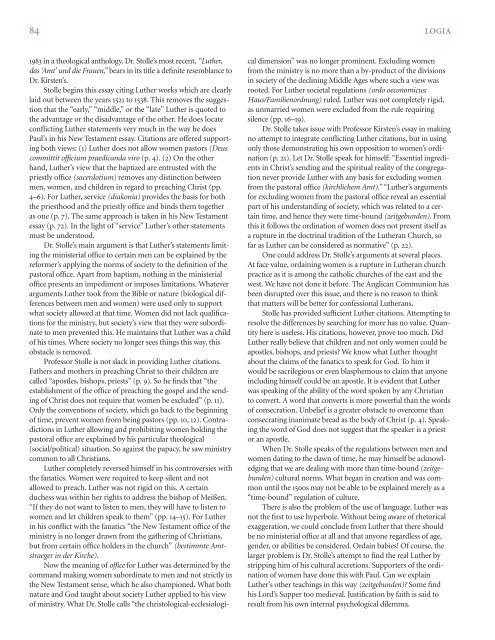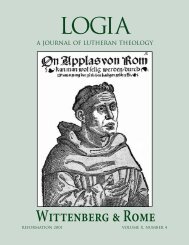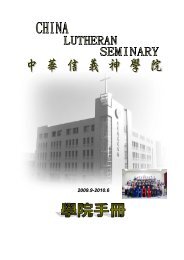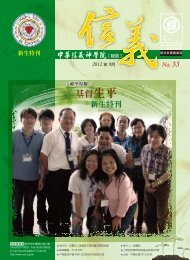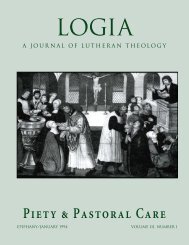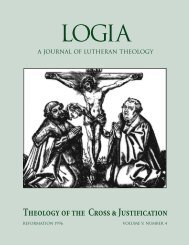04-2 Hermeneutics.pdf
04-2 Hermeneutics.pdf
04-2 Hermeneutics.pdf
- No tags were found...
You also want an ePaper? Increase the reach of your titles
YUMPU automatically turns print PDFs into web optimized ePapers that Google loves.
84 LOGIA1983 in a theological anthology. Dr. Stolle’s most recent, “Luther,das ‘Amt’ und die Frauen,” bears in its title a definite resemblance toDr. Kirsten’s.Stolle begins this essay citing Luther works which are clearlylaid out between the years 1521 to 1538. This removes the suggestionthat the “early,” “middle,” or the “late” Luther is quoted tothe advantage or the disadvantage of the other. He does locateconflicting Luther statements very much in the way he doesPaul’s in his New Testament essay. Citations are offered supportingboth views: (1) Luther does not allow women pastors (Deuscommittit officium praedicanda viro (p. 4). (2) On the otherhand, Luther’s view that the baptized are entrusted with thepriestly office (sacerdotium) removes any distinction betweenmen, women, and children in regard to preaching Christ (pp.4–6). For Luther, service (diakonia) provides the basis for boththe priesthood and the priestly office and binds them togetheras one (p. 7). The same approach is taken in his New Testamentessay (p. 72). In the light of “service” Luther’s other statementsmust be understood.Dr. Stolle’s main argument is that Luther’s statements limitingthe ministerial office to certain men can be explained by thereformer’s applying the norms of society to the definition of thepastoral office. Apart from baptism, nothing in the ministerialoffice presents an impediment or imposes limitations. Whateverarguments Luther took from the Bible or nature (biological differencesbetween men and women) were used only to supportwhat society allowed at that time. Women did not lack qualificationsfor the ministry, but society’s view that they were subordinateto men prevented this. He maintains that Luther was a childof his times. Where society no longer sees things this way, thisobstacle is removed.Professor Stolle is not slack in providing Luther citations.Fathers and mothers in preaching Christ to their children arecalled “apostles, bishops, priests” (p. 9). So he finds that “theestablishment of the office of preaching the gospel and the sendingof Christ does not require that women be excluded” (p. 11).Only the conventions of society, which go back to the beginningof time, prevent women from being pastors (pp. 10, 12). Contradictionsin Luther allowing and prohibiting women holding thepastoral office are explained by his particular theological(social/political) situation. So against the papacy, he saw ministrycommon to all Christians.Luther completely reversed himself in his controversies withthe fanatics. Women were required to keep silent and notallowed to preach. Luther was not rigid on this. A certainduchess was within her rights to address the bishop of Meißen.“If they do not want to listen to men, they will have to listen towomen and let children speak to them” (pp. 14–15). For Lutherin his conflict with the fanatics “the New Testament office of theministry is no longer drawn from the gathering of Christians,but from certain office holders in the church” (bestimmte Amtstraegerin der Kirche).Now the meaning of office for Luther was determined by thecommand making women subordinate to men and not strictly inthe New Testament sense, which he also championed. What bothnature and God taught about society Luther applied to his viewof ministry. What Dr. Stolle calls “the christological-ecclesiologi-cal dimension” was no longer prominent. Excluding womenfrom the ministry is no more than a by-product of the divisionsin society of the declining Middle Ages where such a view wasrooted. For Luther societal regulations (ordo oeconomicus;Haus/Familienordnung) ruled. Luther was not completely rigid,as unmarried women were excluded from the rule requiringsilence (pp. 16–19).Dr. Stolle takes issue with Professor Kirsten’s essay in makingno attempt to integrate conflicting Luther citations, but in usingonly those demonstrating his own opposition to women’s ordination(p. 21). Let Dr. Stolle speak for himself: “Essential ingredientsin Christ’s sending and the spiritual reality of the congregationnever provide Luther with any basis for excluding womenfrom the pastoral office (kirchlichem Amt).” “Luther’s argumentsfor excluding women from the pastoral office reveal an essentialpart of his understanding of society, which was related to a certaintime, and hence they were time-bound (zeitgebunden). Fromthis it follows the ordination of women does not present itself asa rupture in the doctrinal tradition of the Lutheran Church, sofar as Luther can be considered as normative” (p. 22).One could address Dr. Stolle’s arguments at several places.At face value, ordaining women is a rupture in Lutheran churchpractice as it is among the catholic churches of the east and thewest. We have not done it before. The Anglican Communion hasbeen disrupted over this issue, and there is no reason to thinkthat matters will be better for confessional Lutherans.Stolle has provided sufficient Luther citations. Attempting toresolve the differences by searching for more has no value. Quantityhere is useless. His citations, however, prove too much. DidLuther really believe that children and not only women could beapostles, bishops, and priests? We know what Luther thoughtabout the claims of the fanatics to speak for God. To him itwould be sacrilegious or even blasphemous to claim that anyoneincluding himself could be an apostle. It is evident that Lutherwas speaking of the ability of the word spoken by any Christianto convert. A word that converts is more powerful than the wordsof consecration. Unbelief is a greater obstacle to overcome thanconsecrating inanimate bread as the body of Christ (p. 4). Speakingthe word of God does not suggest that the speaker is a priestor an apostle.When Dr. Stolle speaks of the regulations between men andwomen dating to the dawn of time, he may himself be acknowledgingthat we are dealing with more than time-bound (zeitgebunden)cultural norms. What began in creation and was commonuntil the 1500s may not be able to be explained merely as a“time-bound” regulation of culture.There is also the problem of the use of language. Luther wasnot the first to use hyperbole. Without being aware of rhetoricalexaggeration, we could conclude from Luther that there shouldbe no ministerial office at all and that anyone regardless of age,gender, or abilities be considered. Ordain babies! Of course, thelarger problem is Dr. Stolle’s attempt to find the real Luther bystripping him of his cultural accretions. Supporters of the ordinationof women have done this with Paul. Can we explainLuther’s other teachings in this way (zeitgebunden)? Some findhis Lord’s Supper too medieval. Justification by faith is said toresult from his own internal psychological dilemma.


